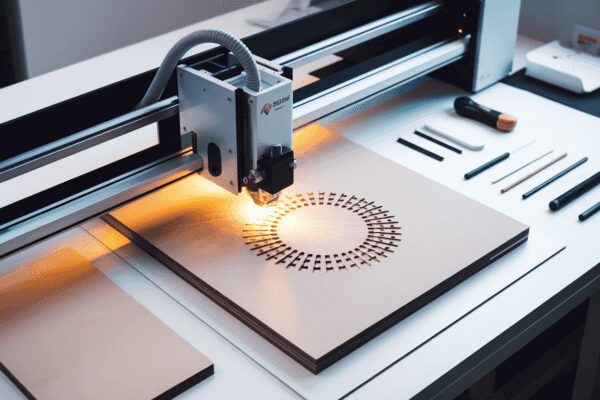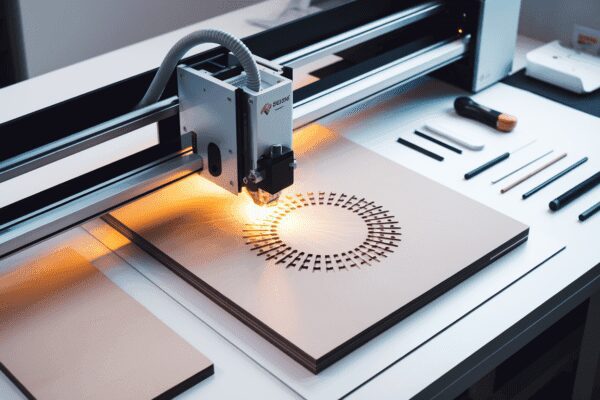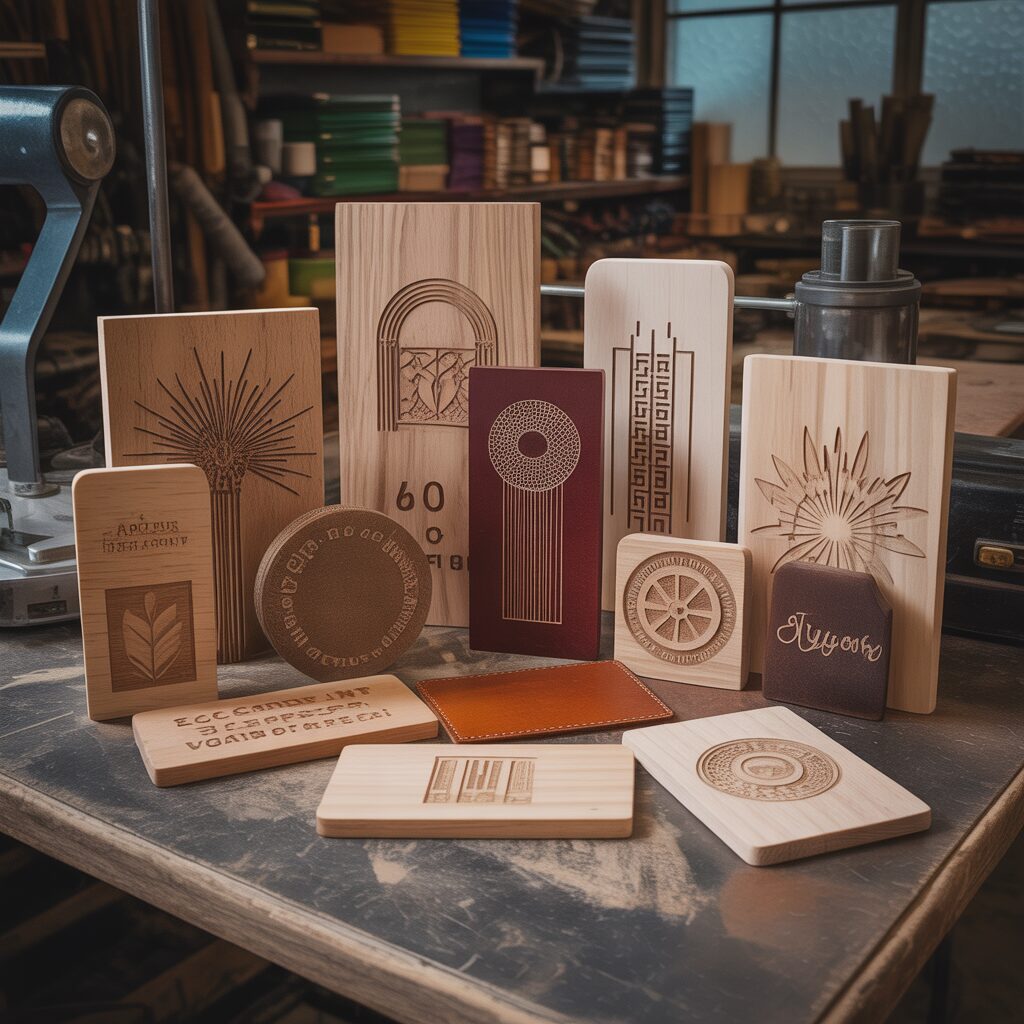The Best Materials for Laser Engraving and How to Choose Them
Estimated reading time: 9 minutes
Key Takeaways
- Material compatibility is paramount in laser engraving, directly influencing engraving depth, pattern clarity, durability, and operational safety.
- Different materials like wood, acrylic, glass, leather, and metal each possess unique properties and require specific handling, safety precautions, and laser settings to achieve optimal results.
- Optimizing engraving settings—power, speed, and frequency—is crucial for fine-tuning the output, preventing material damage, and achieving desired visual and tactile effects.
- Always conduct test engravings on scrap pieces and consult manufacturer recommendations to account for material variability and ensure consistent, high-quality outcomes.
- Choosing the right material should be guided by the project’s intended end-use, aesthetic goals, and the capabilities of your laser system, enabling creative excellence.
Table of Contents
- Understanding Material Compatibility in Laser Engraving
- Why Material Compatibility Matters in Laser Engraving
- Wood: Organic Beauty with Variability
- Acrylic: Crisp Lines with Visual Impact
- Glass: Elegant Markings, Unique Challenges
- Leather: Distinct Texture with Natural Variation
- Metal: Precision Demands and Safety Considerations
- Selecting the Right Material for Your Project
- Optimizing Engraving Settings for Different Materials
- Top Materials for Superior Laser Engraving Results
- Conclusions
- Frequently Asked Questions
Choosing the right material is crucial to achieving exceptional results in laser engraving. In this guide, we explore the best materials for laser engraving, discuss key factors in material compatibility, and provide insights to help you produce crisp, professional results every time.
Understanding Material Compatibility in Laser Engraving
Why Material Compatibility Matters in Laser Engraving
Selecting the right laser engraving materials can make the difference between crisp, professional-quality results and disappointing, flawed creations. Material compatibility directly affects every aspect of the engraving process—dictating the achievable engraving depth, the sharpness of pattern clarity, the overall durability of the finished piece, and, crucially, the safety of the operation. Understanding how different materials respond to laser beams is essential for anyone aiming to achieve superior results and maximize the longevity of their equipment.
Wood: Organic Beauty with Variability
Wood is a classic choice among the best materials for engraving due to its organic warmth and versatility. However, its natural composition yields varying outcomes based on species and grain density. Softer woods like pine and alder tend to produce deeper engravings with minimal power, but lower heat resistance means they may char easily, affecting pattern clarity. Hardwoods such as maple and oak require higher engraving settings but offer finer detail and a smoother finish. Additionally, resin content, moisture, and grain direction significantly influence both the visual sharpness and the tactile feel of engravings. As wood is combustible, proper extraction and fire safety precautions are imperative.
Acrylic: Crisp Lines with Visual Impact
Acrylic is widely favored for projects requiring precise, high-contrast results. Its smooth, homogenous texture ensures consistent performance and exceptional pattern clarity. Cast acrylic, in particular, reacts predictably to laser energy, vaporizing cleanly to create a frosted effect without the risk of burning or excessive melting. Engraving depth is easy to control, making it ideal for intricate designs and signage. However, care must be taken with engraving settings to prevent warping or cloudiness. Acrylic’s fumes can be harmful, so using proper ventilation is a key safety consideration.
Glass: Elegant Markings, Unique Challenges
Glass, although among the most visually striking laser engraving materials, presents a unique set of challenges due to its brittleness and high heat resistance. Rather than cutting into the surface, lasers fracture the top layer, producing elegant, frosty patterns suitable for decorative and gift items. However, pattern clarity can be compromised by micro-cracking, especially on tempered glass. Careful calibration of power and speed is vital to avoid shattering or undesirable rough textures. Working with glass also requires awareness of potential airborne glass dust, warranting both eye protection and effective extraction.
Leather: Distinct Texture with Natural Variation
For those seeking tactile richness, leather stands out among the best materials for engraving. The laser beam darkens or etches the surface, creating striking contrasts and rich textures. Vegetable-tanned leather provides the most reliable results, as chrome-tanned or synthetic variants can emit harmful fumes and produce inconsistent markings. Heat resistance is moderate, so fine-tuning engraving settings is essential to preserve detail without causing excessive discoloration or burning. Always confirm the composition of your leather to prioritize both material compatibility and operator safety.
Metal: Precision Demands and Safety Considerations
Metals such as stainless steel, anodized aluminum, and brass are prized for durability and permanence, but only certain lasers can directly engrave bare metal surfaces. CO2 lasers require marking sprays or specialized coatings for visible results, while fiber lasers are designed for direct engraving. Metals generally possess high heat resistance, meaning higher power and slower speeds are needed for adequate engraving depth. Pattern clarity on polished surfaces may demand multiple passes and precise focus. Given the risk of reflective beams, extra safety measures, including proper eye protection and shielded workspaces, are non-negotiable.
Selecting the Right Material for Your Project
Choosing laser engraving materials begins with evaluating the end-use: Will the item be decorative, functional, or subject to wear? Do you need depth, subtlety, or visual contrast? Prioritize materials with proven material compatibility for your laser type, and always research both their inherent properties and safety profiles. Testing on a sample can reveal how engraving settings, depth, and pattern clarity interact with the chosen medium—ultimately ensuring that your finished project exceeds expectations in both quality and safety.
Optimizing Engraving Settings for Different Materials
Optimizing Engraving Settings for Different Materials
Achieving high-quality results with laser engraving materials hinges on more than just selecting the right substrate; it requires precise control over engraving settings. The three essential parameters—power, speed, and frequency—directly influence engraving depth, pattern clarity, and the overall aesthetic of the finished piece. While material compatibility ensures the substrate reacts safely and predictably to the laser, proper adjustments of the engraving settings are critical for maximizing both performance and visual appeal.
Fine-Tuning Engraving Power
Power determines how much energy the laser delivers to the material’s surface. For softer laser engraving materials, such as wood or leather, lower power prevents excessive burning and scorching. Conversely, harder materials, like metals or glass, generally demand higher laser power to achieve noticeable markings or deeper etching. For example, when working with wood, a moderate power setting can create crisp, dark lines without charring. With acrylic, lower to medium power yields a frosted finish, while excessive power risks melting or warping the surface. Adjusting power upwards is essential for successfully marking stainless steel, but for coated metals, a lower power might suffice to burn off the coating and reveal the design.
Balancing Engraving Speed
Speed defines how quickly the laser passes over the workpiece. Slower speeds increase exposure time, resulting in deeper engraving depths, while faster speeds can produce lighter, more delicate marks with improved pattern clarity. Optimal speed is closely tied to heat sensitivity—a slow pass on a heat-sensitive laser engraving material like leather can cause discoloration or even burn through, so higher speeds are preferable. For durable materials such as anodized aluminum or glass, slower speeds can help achieve strong contrast without loss of definition. As a general rule, test runs using gradient speed settings can reveal the best balance between depth and clarity.
Mastering Frequency Adjustments
Frequency, or pulse rate, defines the number of times per second the laser pulses. Materials react differently to frequency changes, impacting both engraving depth and edge sharpness. A high frequency is suitable for organic materials like wood or acrylic, promoting smooth, even engravings, but can cause melting on plastics or excessive soot on wood if not carefully managed. For metals, lower frequencies can yield cleaner markings with higher pattern clarity and minimal heat-affected zones, essential for intricate designs.
Best Practices for Achieving Superior Results
- Material Testing: Always perform test engravings on a scrap piece of your chosen material. Adjust one engraving setting at a time—beginning with power, followed by speed, and finally frequency—to isolate effects and optimize results for that specific substrate.
- Utilize Manufacturer Recommendations: Reference guidelines supplied by material or machine manufacturers. They often provide starting points for the best materials for engraving, saving both time and material during setup.
- Account for Material Variability: Even within the same category, laser engraving materials may differ in density or composition. Fine-tuning for each individual piece helps maintain engraving depth and consistent pattern clarity, especially with natural materials like wood or stone.
- Clean Surfaces Pre- and Post-Engraving: Dust, oils, or protective films can distort laser focus, impacting both depth and clarity. Cleaning your substrate before and after engraving ensures sharper, more professional results.
- Layered Passes: When deeper engraving is needed—especially with metals or glass—multiple passes at lower power and slower speed can prevent damaging heat build-up, preserving pattern definition and substrate integrity.
By methodically adjusting engraving settings for optimal material compatibility, artisans and professionals can unleash the creative possibilities inherent in the best materials for engraving. Tailoring parameters for each substrate guarantees superior outcomes whether your goal is bold, deep etching or intricate, delicate patterns.
Top Materials for Superior Laser Engraving Results
Wood: Versatile & Timeless
Wood remains one of the best materials for engraving due to its organic texture, versatility, and wide material compatibility with different laser types. Materials such as maple, cherry, birch, and alder are especially popular among professionals for their consistent grain patterns and appealing color contrast when engraved. Wood yields engravings of impressive depth and pattern clarity, adding a warm, natural aesthetic to an array of products—from custom signage and awards to home décor and personalized gifts.
When selecting wood, consider the hardness and resin content. Hardwoods typically produce crisper engravings, while softwoods may char more easily, affecting pattern clarity. For optimal results, choose woods with even grains and minimal knots. Keep in mind that engraving settings may need subtle adjustments for different species: lower power and higher speed work best for light, resin-rich woods to prevent excessive darkening, while harder woods can withstand higher power levels. Creative users often experiment with different stains and finishes to further enhance the engraved contrast and visual appeal.
Acrylic: Precision and Vivid Contrast
Acrylic is another top choice in the landscape of laser engraving materials, renowned for its modern aesthetic, sharp engraving outcomes, and excellent material compatibility. Both cast and extruded acrylic are commonly used, though cast acrylic delivers superior engraving depth and frosted pattern clarity due to its reactive properties with laser energy. This material is favored for awards, signage, edge-lit displays, and artistic décor pieces, offering crisp, high-contrast designs that catch the eye.
Acrylic is cost-effective and easy to handle, making it popular among hobbyists and professionals alike. The key to successful results is selecting the right engraving settings for the specific acrylic type—cast acrylic benefits from lower power and moderate speed for clear, frosted engravings, while extruded acrylic may require fine-tuning to avoid melting or rough edges. To promote creativity, consider experimenting with colored and mirrored acrylics, which open up a myriad of design possibilities.
Glass: Elegant Detailing
Glass offers a unique, upscale look that elevates items such as awards, drinkware, ornaments, and corporate gifts. The best materials for engraving in this category include soda-lime and leaded crystal glass, both providing excellent clarity when properly handled. Achieving fine engraving depth and sharp pattern clarity requires precise laser settings to prevent fracturing or excessive frosting.
Professional engravers often use masking, damp paper, or specialized pastes to minimize heat dispersion and enhance the quality of the engraving outcome. While glass engraving can be more challenging due to the risk of chipping or cracks, mastering the technique allows for stunningly intricate artwork that can’t be replicated by other methods.
Metals: Industrial Strength and Durability
Laser engraving on metals—aluminum, stainless steel, brass, and coated metals—yields results of unmatched permanence and clarity. Material compatibility depends on the laser system; fiber lasers are ideal for bare metals, while CO₂ lasers can work with anodized or coated surfaces. Metals are widely appreciated for their resilience, making them the go-to for industrial tags, tools, jewelry, plaques, and branding.
For best results, fine-tune engraving settings for each metal type. Coated metals, like anodized aluminum, deliver exceptional pattern clarity and color contrast with minimal power, while bare metals may require marking solutions or higher-power lasers to achieve the desired engraving depth. Creative professionals often utilize color-marking techniques on stainless steel to add a vibrant, modern twist to their projects.
Leather: Organic Sophistication
Genuine leather introduces flexibility and tactile richness to the repertoire of laser engraving materials. Leather is suited for crafting bespoke goods such as wallets, belts, journals, and fashion accessories. The organic fibers of natural leather respond to laser energy by darkening in engraved areas, creating a striking effect with excellent pattern clarity. Conversely, synthetic leathers may emit toxic fumes and should only be used if confirmed as laser-safe.
Select lighter-colored, vegetable-tanned leathers for the most dramatic engraving contrast, and always test settings to control depth and avoid excessive burn marks. Conditioning the leather post-engraving can further enhance longevity and vibrance, ensuring your project not only looks great but feels great too.
Tips for Creative Excellence in Material Selection
Explore diverse laser engraving materials to discover new textures, effects, and applications. Informed choices based on material compatibility, desired engraving depth, and intended end-use will expand your creative boundaries. Regularly test and document your engraving settings for each material to archive best practices, ensuring repeatable, high-quality results and maximizing your artistic potential in every engraving project.
Conclusions
Selecting the ideal material can transform your laser engraving projects from ordinary to outstanding. By understanding material compatibility, recommended settings, and the effects on pattern clarity and engraving depth, you’ll maximize both the quality and creativity of your work.
Frequently Asked Questions
Q: Why is material compatibility so important in laser engraving?
A: Material compatibility is crucial because it directly influences the achievable engraving depth, sharpness of pattern clarity, overall durability of the finished piece, and, most importantly, the safety of the operation. Different materials react uniquely to laser energy, affecting everything from charring in wood to melting in acrylic or fracturing in glass.
Q: What are the main differences between engraving cast acrylic and extruded acrylic?
A: Cast acrylic is generally preferred for engraving as it vaporizes cleanly to create a consistent, frosted effect with superior engraving depth and pattern clarity. Extruded acrylic, on the other hand, may melt or produce rougher edges if engraving settings are not precisely fine-tuned, as it tends to react differently to laser energy.
Q: How do power, speed, and frequency impact laser engraving results?
A: Power dictates the laser’s energy delivery, affecting how deeply or noticeably a material is marked. Speed determines how quickly the laser moves, influencing exposure time and thus engraving depth and lightness of marks. Frequency (pulse rate) affects edge sharpness and how smoothly a material responds to the laser, especially for organic materials or to minimize heat-affected zones in metals.
Q: What safety considerations are important when laser engraving different materials?
A: Safety considerations vary by material. Wood is combustible and requires fire safety. Acrylic and some leathers (especially chrome-tanned or synthetic) can emit harmful fumes, necessitating proper ventilation. Glass work carries a risk of micro-cracking and airborne glass dust, requiring eye protection. Metals, due to reflective beams, demand extra safety measures like shielded workspaces and specific eye protection.
Q: What is the best practice for optimizing engraving settings for a new material?
A: The best practice is to always perform test engravings on a scrap piece of the material. Adjust one engraving setting at a time—starting with power, then speed, and finally frequency—to isolate the effects and optimize results for that specific substrate. Consulting manufacturer recommendations and cleaning surfaces thoroughly are also crucial for achieving superior and consistent outcomes.


Subscribe to Our Newsletter
And enjoy FREE Download Files, SALE Alerts and Inspiring TIPS


A Comprehensive Guide to Laser Engraving Slate
Creating the Perfect Engraved Charcuterie Board
A Guide to Creating Your Own Engraved Charcuterie Board
Valentine Love Captions: 6 Charcuterie Board Engraving Files…
$8.00Original price was: $8.00.$5.60Current price is: $5.60.(30% off)
American Eagle Flag Laser Engraving File for Charcuterie & Cutting…
$4.00Original price was: $4.00.$2.80Current price is: $2.80.(30% off)
Bee and Honey Jar Charcuterie Board Engraving File | PNG Download #007…
$4.00Original price was: $4.00.$3.20Current price is: $3.20.(20% off)
Bee & Hive Charcuterie Board Engraving – HQ PNG Download…
$4.00Original price was: $4.00.$2.80Current price is: $2.80.(30% off)